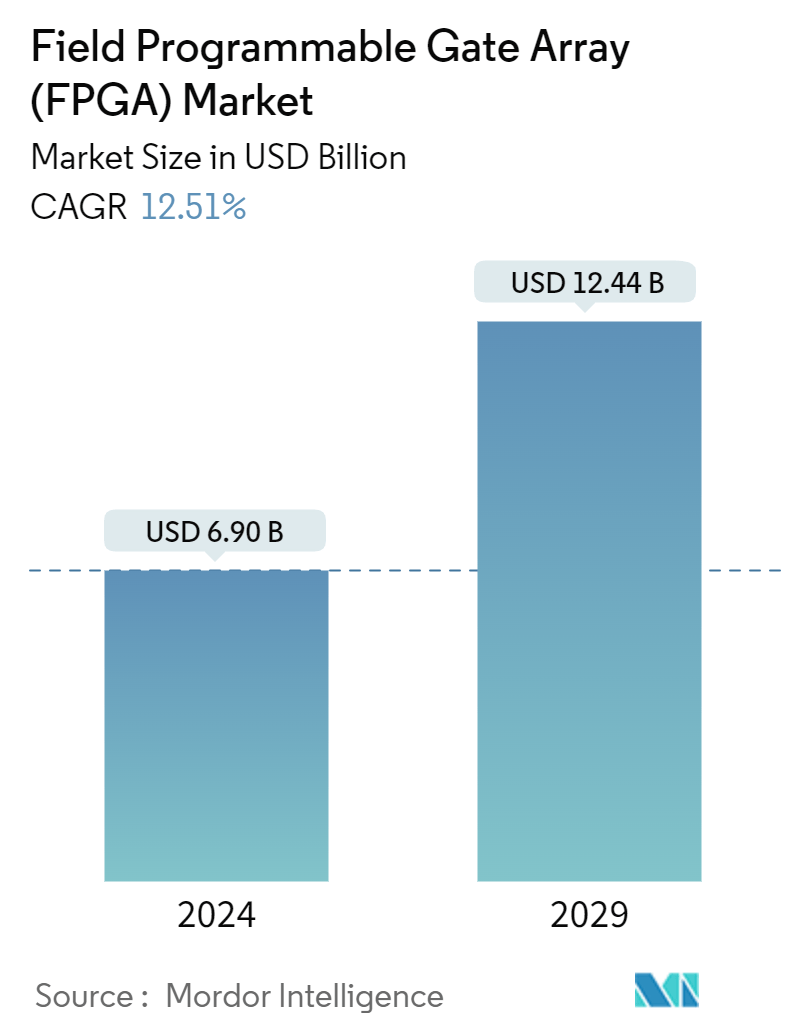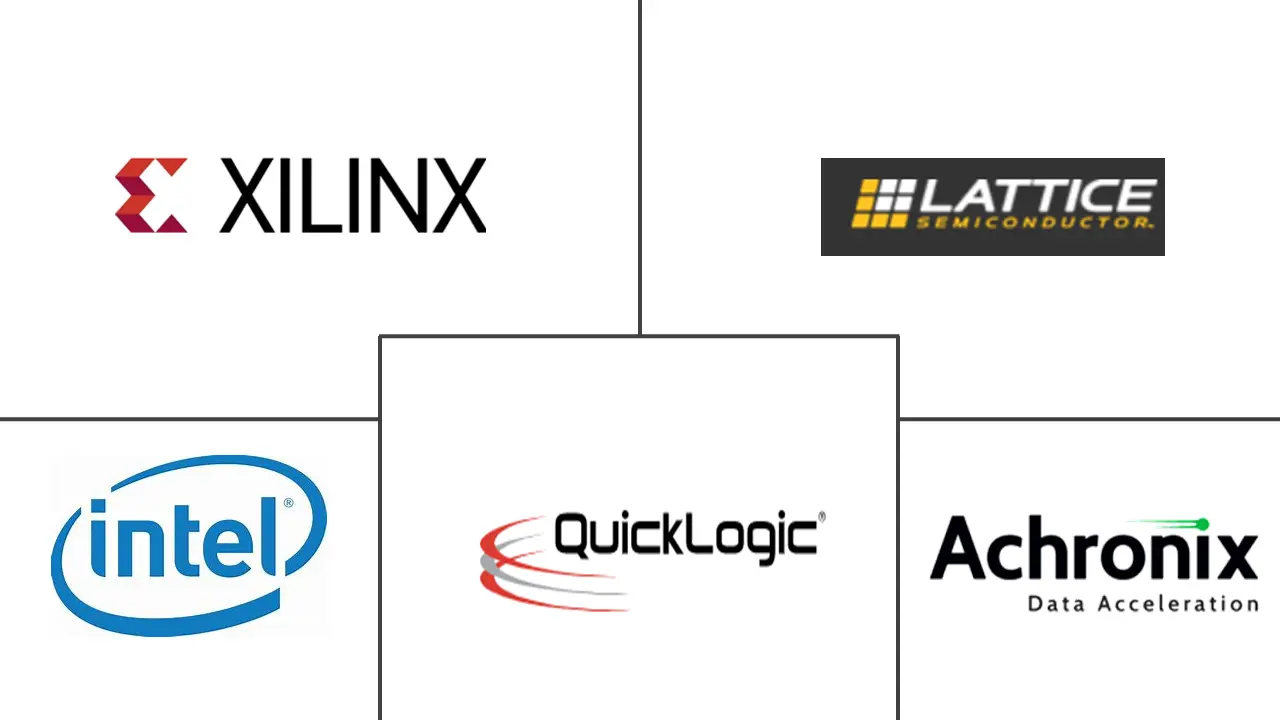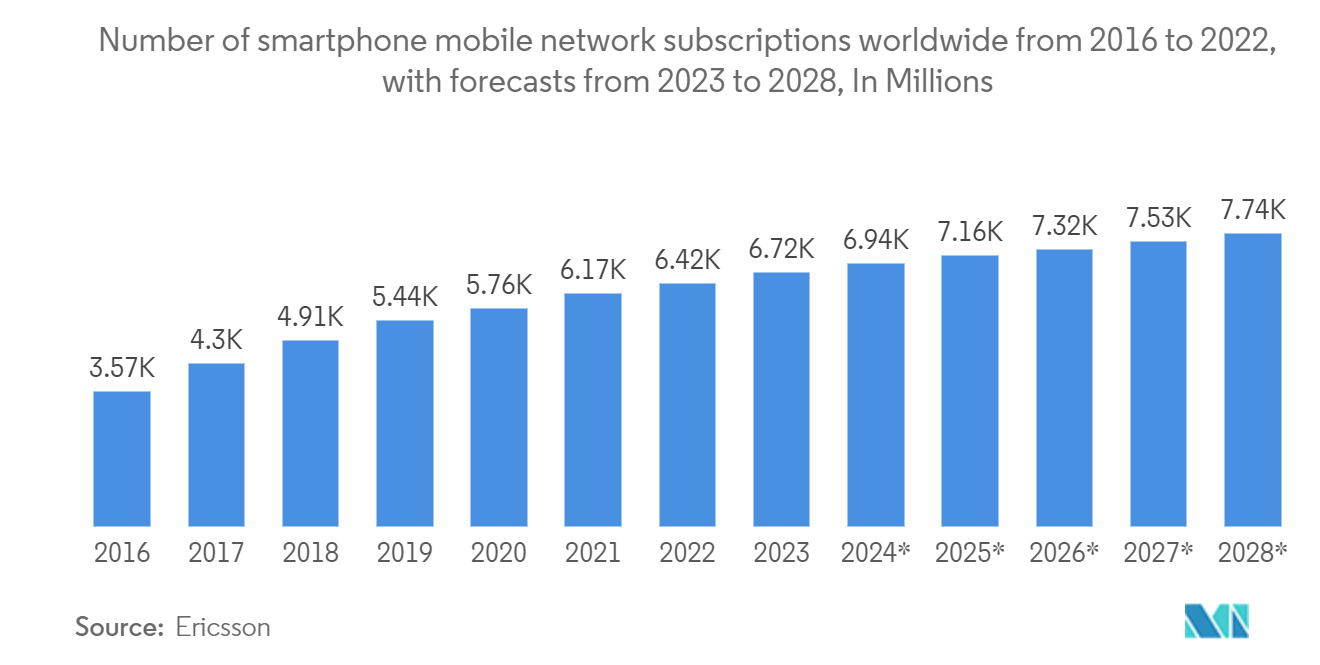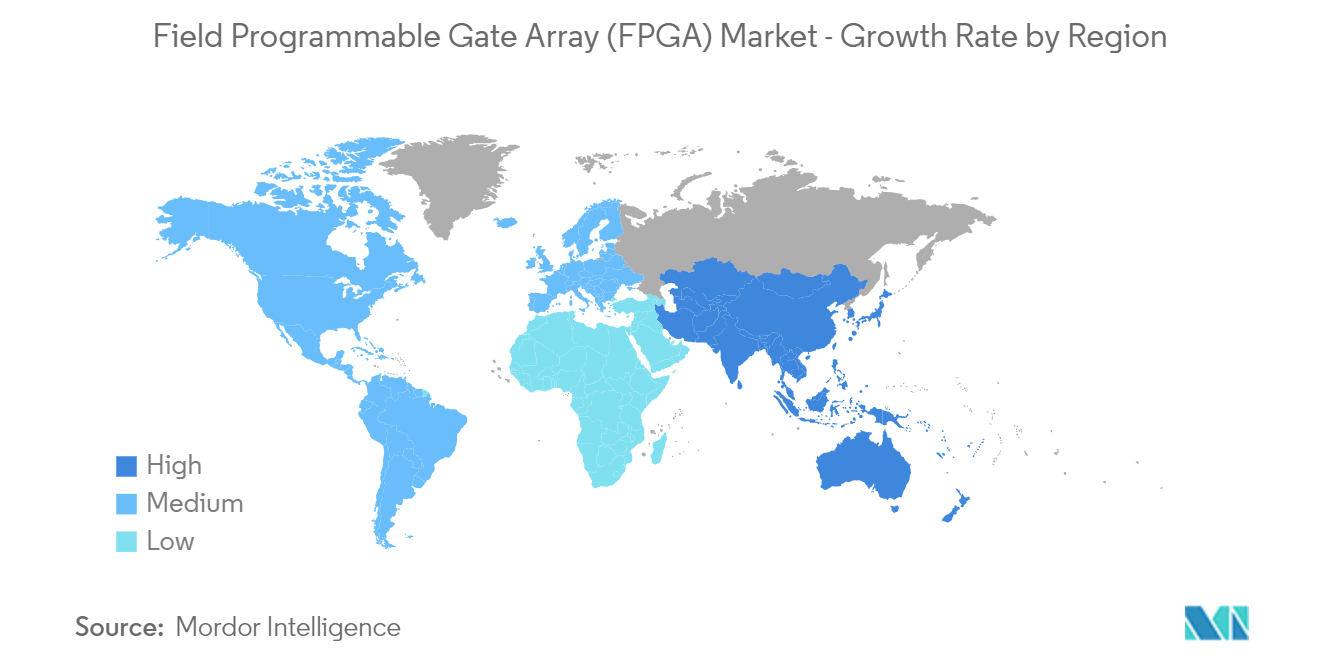Field Programmable Gate Array (FPGA) Market Size

| Study Period | 2019 - 2029 |
| Market Size (2024) | USD 6.90 Billion |
| Market Size (2029) | USD 12.44 Billion |
| CAGR (2024 - 2029) | 12.51 % |
| Fastest Growing Market | Asia Pacific |
| Largest Market | Asia Pacific |
Major Players
*Disclaimer: Major Players sorted in no particular order |
Need a report that reflects how COVID-19 has impacted this market and its growth?
Field Programmable Gate Array (FPGA) Market Analysis
The Field Programmable Gate Array Market size is estimated at USD 6.90 billion in 2024, and is expected to reach USD 12.44 billion by 2029, growing at a CAGR of 12.51% during the forecast period (2024-2029).
• The Field Programmable Gate Arrays can be defined as Integrated Circuits, which can be reprogrammable, enabling customers the ability to reconfigure the hardware to meet specific use case requirements after the manufacturing process, allowing for feature upgrades and bug fixes to be performed in remote deployment conditions, driving the growth of the market. Field programmable gate arrays (FPGAs) incorporate circuits with a programmable hardware fabric. Unlike ASICs or graphics processing units (GPUs), the circuitry inside an FPGA chip is not hard etched; it can be reprogrammed as required. This capability makes FPGAs a suitable alternative to ASICs, which need a long development time and a significant investment to design and fabricate, supporting its market demand during the forecast period.
• FPGAs are used in the technology industry for machine learning and deep learning. Microsoft Research displayed one of the first use cases of AI on FPGAs in the last decade as part of the company's efforts to speed up web searches. FPGAs provide a combination of programmability, speed, and flexibility, delivering performance without high cost and complexity to develop custom application-specific integrated circuits (ASICs). Microsoft's Bing search engine also uses FPGAs in production, indicating their value for deep learning applications. According to the company, Bing realized a 50% increase in throughput using FPGAs to accelerate search ranking, showing the increasing application of GPGA ICs in the market.
• In addition, FPGAs deliver hardware customization with integrated AI and can be programmed to provide behavior like an ASIC or a GPU. The reconfigurable, reprogrammable nature of an FPGA makes itself well suited for a rapidly evolving AI landscape, enabling designers to test algorithms quickly and get to market fast. High Power Consumption Compared to ASIC, which is restraining the market growth. Energy efficiency has always been a significant concern across various industries. Industries incorporating electronic devices always seek low-power-consuming devices. In FPGAs, power consumption is higher, and programmers do not have any control over power optimization.
• However, designing FPGA presents a significant challenge due to the complexity of the architecture and the high-power consumption due to its advanced capabilities. Additionally, the cost of these FPGAs is higher than other alternatives, making them less accessible to small and medium-sized businesses, creating a future market challenge for the FGPAs's adoption.
• The demand for data centers, artificial intelligence, and machine learning across government, enterprises, and academic entities is witnessing exponential growth due to the COVID-19 pandemic and other Macroeconomic trends, including the development of digital economies, smart cities, and other factors worldwide. This growth has positively impacted the need for FPGAs. It is predicted that FPGAs will maintain the same pace in the forecasted period, helping spread the impact and significance of FPGAs in various end-user industries.
Field Programmable Gate Array (FPGA) Market Trends
Consumer Electronic Segment is Expected to Drive the Market Growth
• Consumer electronic products are improving and continually adding features and integrating new technologies to enhance video connectivity, quality, and artificial intelligence (AI) capabilities. Keeping up with these innovations and raising time pressure on consumer electronics manufacturers supports the demand for FPGAs due to their agility and customization-friendly features to support the growth of the high demand volume of consumer electronic products.
• The emergence of Smart home consumer electronic products is becoming the new norm, with homeowners managing security, lighting, networked appliances, outdoor irrigation, climate, and entertainment systems, creating an opportunity for market growth due to the application of FPGAs in developing feature-rich consumer devices such as smartphones, digital displays, home networking equipment, and set-top boxes, driving the market growth.
• Additionally, the applications of FPGAs for video and audio processing, image recognition, and signal processing are in growing demand in consumer electronic products. FPGAs can also be used to implement encryption and decryption algorithms, essential for secure communication in modern consumer electronics, fueling the market's growth in line with the increased risk of cyber-attacks on electronic devices worldwide.
• The market has been registering significant growth supported by the increasing priority of consumer electronics manufacturers to partner and invest in the development of FPGA solutions in the market. For instance, in December 2023, Samsung Electronics and South Korean internet giant Naver partnered to invest in an artificial intelligence semiconductor solution, the energy efficiencies chip based on a Field-Programmable Gate Array (FPGA) customized for Naver’s HyperCLOVA X large language model, showing the importance of FPGA solutions development in the consumer electronic segments, which would support the market growth.
• FPGA’s parallel processing architecture enables the execution of complex audio algorithms with minimal delay. This ensures that audio signals are processed swiftly and delivered to the listener’s ears without perceptible lag, creating a seamless and immersive audio experience and supporting its demand with the growth of consumer electronic products worldwide. Additionally, in smartphones, FPGAs play a crucial role in power efficiency. They can intelligently control power by rearranging their circuitry to dynamically adjust power consumption, fueling the market growth with the increasing number of smartphones.

Asia-Pacific is Expected to Hold a Significant Market Share
• Asia-Pacific is a significant region for the players operating in the FPGA industry. Within the Asia Pacific, many nations, including China, India, South Korea, Taiwan, and others, have seen an enormous increase in the consumer electronics industry in the past few years. As a result, the demand for FPGAs in the area is seen as an influence point.
• According to the Semiconductor Equipment and Material International (SEMI), China is a significant spender on semiconductor equipment, followed by South Korea, Taiwan, and Japan. Furthermore, China is expected to maintain the top position in semiconductor equipment spending this year, while Taiwan is anticipated to regain the lead in 2024. In addition, the Chinese government encouraged its national champions and top digital enterprises to develop their domestic semiconductor manufacturing capacities to rebalance China's reliance on overseas semiconductor demand. Such an initiative may further boost the semiconductor market, propelling the demand for FPGA.
• The 5G adoption is rising in momentum for both the network and device domains. The Chinese telecom sector has experienced rapid evolution in recent years, which is expected to continue until 2025. Increased population, communication services, and smartphone use fuel the industry's development. Premium connectivity and content services in China account for the majority of the market development in the country.
• Additionally, Field Programmable Gate Arrays (FPGAs) have gained substantial attention within the semiconductor sector. FPGAs are unique silicon chips characterized by their adaptability and advanced features. Their reprogrammable nature and high-speed parallel processing capabilities make them ideal for various applications in data centers, automotive, telecommunications, aerospace, and defense industries, supporting the growth of the market in developing economies, including India, in line with the development of semiconductor manufacturing and make in India programs of the country, which can fuel the market growth in Asia-Pacific.
• China is paving the way for the FPGA market to expand. The country's demand is extending due to its significant position as the international manufacturer of consumer electronics gadgets. China is the world's largest manufacturing hub, producing 36% of the world's electronics, including smartphones, computers, cloud servers, and telecom infrastructure, establishing the country as the global electronics supply chain's most important node. The popularity of AI in China has opened up new development potential for the Chinese consumer electronics market. Smart homes and IoT (Internet of Things) will likely be significant development potential for manufacturers of FPGA in the next decade.

Field Programmable Gate Array (FPGA) Industry Overview
The Field Programmable Gate Array (FPGA) Market is moderately fragmented, with the presence of major players like Xilinx Inc., Lattice Semiconductor Corporation, Quicklogic Corporation, Intel Corporation, and Achronix Semiconductor Corporation. Players in the market are adopting strategies such as partnerships, expansions, and acquisitions to enhance their product offerings and gain sustainable competitive advantage.
• December 2023 - Intel planned to expand its Intel Agilex FPGA portfolio to address customers' growing needs, broaden its Programmable Solutions Group (PSG) offerings to handle the increased demand for customized workloads, including enhanced AI capabilities, and provide lower total cost of ownership (TCO) and more complete solutions.
• October 2023 - Lattice Semiconductor announced its Lattice FPGAs would be used in the advanced driver experiences on Mazda Motor Corporation's new CX-60 and CX-90 models. The Mazda crossover SUVs leverage the interface bridging solution based on multiple low-power Lattice FPGAs to provide a safety-critical Advanced Driver Assistance System, including a more comprehensive detection range, improved detection accuracy, and spatial recognition performance without decreasing vehicle performance.
Field Programmable Gate Array (FPGA) Market Leaders
Xilinx, Inc.
Lattice Semiconductor Corporation
Quicklogic Corporation
Intel Corporation
Achronix Semiconductor Corporation
*Disclaimer: Major Players sorted in no particular order
_Market_conc.webp)
Field Programmable Gate Array (FPGA) Market News
• February 2024 - WPG Americas Inc. announced an expanded field-programmable gate array (FPGA) product offering through a new distribution agreement with Efinix, an innovator in programmable logic solutions. Under the agreement, WPGA would offer the Efinix Titanium and Trion FPGA product lines to customers across the Americas, driving the overall FPGA market growth in the future.
• August 2023 - QuickLogic and YorChip partnered strategically to develop Low-Power, Low-Cost UCIe FPGA Chiplets. These chiplets are optimized for low power consumption and low cost, opening new possibilities for a wide range of applications, including the fast-growing edge IoT and AI/ML markets, which would support the market growth.
Field Programmable Gate Array (FPGA) Market Report - Table of Contents
1. INTRODUCTION
1.1 Study Assumptions and Market Definition
1.2 Scope of the Study
2. RESEARCH METHODOLOGY
3. EXECUTIVE SUMMARY
4. MARKET INSIGHTS
4.1 Market Overview
4.2 Industry Value Chain Analysis
4.3 Industry Attractiveness - Porter's Five Forces Analysis
4.3.1 Bargaining Power of Suppliers
4.3.2 Bargaining Power of Consumers
4.3.3 Threat of New Entrants
4.3.4 Intensity of Competitive Rivalry
4.3.5 Threat of Substitutes
4.4 Impact of Macro Economic trends on the Industry
5. MARKET DYNAMICS
5.1 Market Drivers
5.1.1 Increasing Demand for IoT
5.2 Market Restraints
5.2.1 High Power Consumption Compared to ASIC
6. MARKET SEGMENTATION
6.1 By Configuration
6.1.1 High-end FPGA
6.1.2 Mid-range FPGA/Low-end FPGA
6.2 By Architecture
6.2.1 SRAM-based FPGA
6.2.2 Anti-fuse Based FPGA
6.2.3 Flash-based FPGA
6.3 By End-user Industry
6.3.1 IT and Telecommunication
6.3.2 Consumer Electronics
6.3.3 Automotive
6.3.4 Industrial
6.3.5 Military and Aerospace
6.3.6 Other End-user Industries
6.4 By Geography
6.4.1 North America
6.4.1.1 United States
6.4.1.2 Canada
6.4.2 Europe
6.4.2.1 Germany
6.4.2.2 United Kingdom
6.4.2.3 France
6.4.2.4 Rest of Europe
6.4.3 Asia-Pacific
6.4.3.1 China
6.4.3.2 Japan
6.4.3.3 India
6.4.3.4 South Korea
6.4.3.5 Rest of the Asia-Pacific
6.4.4 Latin America
6.4.4.1 Brazil
6.4.4.2 Argentina
6.4.4.3 Mexico
6.4.4.4 Rest of Latin America
6.4.5 Middle East and Africa
6.4.5.1 United Arab Emirates
6.4.5.2 Saudi Arabia
6.4.5.3 South Africa
6.4.5.4 Rest of Middle East and Africa
7. COMPETITIVE LANDSCAPE
7.1 Company Profiles
7.1.1 Xilinx Inc.
7.1.2 Lattice Semiconductor Corporation
7.1.3 Quicklogic Corporation
7.1.4 Intel Corporation
7.1.5 Achronix Semiconductor Corporation
7.1.6 GOWIN Semiconductor Corporation
7.1.7 Microchip Technology Incorporated
7.1.8 Efinix Inc.
- *List Not Exhaustive
8. VENDOR MARKET SHARE ANALYSIS
9. INVESTMENT ANALYSIS
10. FUTURE OF THE MARKET
Field Programmable Gate Array (FPGA) Industry Segmentation
FPGAs are prefabricated silicon instruments that can be electrically programmed in the field to become almost any type of digital circuit or system. They are an array of configurable logic blocks (CLBs) linked together by programmable interconnects. After manufacturing, they can be reprogrammed to meet the needs of the desired application or functionality.
The studied market is segmented by Configuration (High-end FPGA, Mid-range FPGA/Low-end FPGA), by Architecture (SRAM-based FPGA, Anti-fuse Based FPGA, Flash-based FPGA), by End-user Industry (IT and Telecommunication, Consumer Electronics, Automotive, Industrial, Military and Aerospace), by Geography (North America (United States, Canada), Europe (Germany, United Kingdom, France, Rest of Europe), Asia-Pacific (China, Japan, India, South Korea, Rest of the Asia Pacific), Latin America (Brazil, Argentina, Mexico, Rest of Latin America), Middle East and Africa (United Arab Emirates, Saudi Arabia, South Africa, Rest of Middle East and Africa)). The market sizes and forecasts are provided in terms of value in USD for all the above segments.
| By Configuration | |
| High-end FPGA | |
| Mid-range FPGA/Low-end FPGA |
| By Architecture | |
| SRAM-based FPGA | |
| Anti-fuse Based FPGA | |
| Flash-based FPGA |
| By End-user Industry | |
| IT and Telecommunication | |
| Consumer Electronics | |
| Automotive | |
| Industrial | |
| Military and Aerospace | |
| Other End-user Industries |
| By Geography | |||||||
| |||||||
| |||||||
| |||||||
| |||||||
|
Field Programmable Gate Array (FPGA) Market Research FAQs
How big is the Field Programmable Gate Array Market?
The Field Programmable Gate Array Market size is expected to reach USD 6.90 billion in 2024 and grow at a CAGR of 12.51% to reach USD 12.44 billion by 2029.
What is the current Field Programmable Gate Array Market size?
In 2024, the Field Programmable Gate Array Market size is expected to reach USD 6.90 billion.
Who are the key players in Field Programmable Gate Array Market?
Xilinx, Inc., Lattice Semiconductor Corporation, Quicklogic Corporation, Intel Corporation and Achronix Semiconductor Corporation are the major companies operating in the Field Programmable Gate Array Market.
Which is the fastest growing region in Field Programmable Gate Array Market?
Asia Pacific is estimated to grow at the highest CAGR over the forecast period (2024-2029).
Which region has the biggest share in Field Programmable Gate Array Market?
In 2024, the Asia Pacific accounts for the largest market share in Field Programmable Gate Array Market.
What years does this Field Programmable Gate Array Market cover, and what was the market size in 2023?
In 2023, the Field Programmable Gate Array Market size was estimated at USD 6.04 billion. The report covers the Field Programmable Gate Array Market historical market size for years: 2019, 2020, 2021, 2022 and 2023. The report also forecasts the Field Programmable Gate Array Market size for years: 2024, 2025, 2026, 2027, 2028 and 2029.
Field Programmable Gate Array Industry Report
Statistics for the 2024 Field Programmable Gate Array (FPGA) market share, size and revenue growth rate, created by Mordor Intelligence™ Industry Reports. Field Programmable Gate Array (FPGA) analysis includes a market forecast outlook to for 2024 to 2029 and historical overview. Get a sample of this industry analysis as a free report PDF download.
